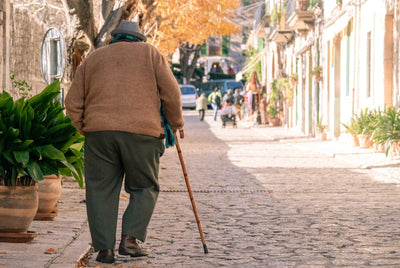Best Bed Height for the Elderly: How to Improve Bed Safety
The best bed height for the elderly can vary depending on some factors, including the person's height, weight, and physical abilities.
In general, however, a bed that is too low can be more difficult for an elderly person to get in and out of, while a bed that is too high can be more dangerous, particularly if the person has difficulty balancing.
The ideal bed height for an elderly person is somewhere in the middle, where the person can easily get in and out of bed without too much difficulty.
The Best Bed Height for Seniors
The Disability Rights Education and Defense Fund now recommends a bed height of 20 to 23 inches from the top of the mattress to the floor. On the other hand, this advice is more concerned with making it easier to get in and out of bed from a wheelchair than with what is best for a certain elderly person.
Because not all older people use wheelchairs, height is a more important consideration. Even age-related height loss does not change the reality that older individuals come in many shapes and sizes, and the appropriate bed height should be adjusted to their specific needs.
Individuals should ideally be able to ease themselves into a sitting position with both feet firmly planted on the floor, without straining or requiring the assistance of their hands.
High Bed
Higher beds are usually suggested for the elderly since they are thought simpler. While high beds make it easier to get out of bed, they also make it more difficult. This is why bed steps for the elderly should be considered.
Indicators of an Overly High Bed
When resting against a bed, the thighs or buttocks should be pressed on the top of the mattress.
- The seniors must stand on their toes or use their hands to get onto the bed.
- The feet are not flat when seated and properly planted on the floor.
- The knees are lower in alignment than the hips.
- The senior is not seated far back and is balancing on the edge of the bed.
The Benefits of a Higher Bed
Surprisingly, having a taller bed has certain perks.
- It is easier to get out of a higher bed.
- Under the bed, there is additional storage space.
- Cleaning beneath a raised bed is simple.
The Drawbacks of a Higher Bed
- Getting out of bed several times during the night raises the danger of falling.
- A fall increases the possibility and severity of harm.
- Taller beds take up more space and may make a room feel claustrophobic.
Low Bed
Low beds, however, are frequently advised, particularly for seniors prone to falling out of bed. While they have a place in dementia care, they are unsuitable for the vast majority of the elderly.
Indicators of a Low-Level Bed
If the bed is excessively low, you may observe the following:
- Rather than easing themselves onto the bed, the senior collapses into a sitting position.
- By laying their hands behind or alongside them, the senior is relaxing.
- The elderly person is attempting to sit and bending too far forward.
- The senior either misses the bed or believes they are almost seated, ending in a collapse.
- The senior has trouble getting up from a seated posture. It is more difficult to get out of bed when the knees are higher than the hips.
Injuries from too-low mattresses might happen from straining or falling, so you may buy a bed ladder for the elderly.
The Benefits of a Lower Bed
- A lower bed is recommended if the senior is prone to falling out of bed when sleeping or waking up because it decreases the danger of catastrophic damage.
- It lessens the likelihood of muscle stress and damage.
- According to a study, sleeping closer to the earth enhances sleep quality.
The Drawbacks of a Lower Bed
- A low-lying bed is far more difficult to get out of, which increases the risk of falling.
- The natural storage space beneath the bed has been decreased or removed.
Alternatives for Improving Elderly Bed Safety
It is not essential to buy a new bed or lower or raise an old one. Some solutions can help a senior get in and out of bed while reducing the danger of injury.
Purchase a bed step stool for the elderly to access a higher bed. This is a good idea because it makes getting out of a high bed easier.
Install a bed rail if you are worried about falling out of bed. You can use the rail as a handhold when getting into and out of bed.
Install a night light to help you see where you're going when you get in and out of bed.
Check that bed sheets, base coverings, and other linen do not pose a tripping hazard and are kept safe from the floor.
Conclusion
The best bed height for the elderly depends on various factors such as the individual's mobility, health condition, and preference. A higher bed may be better for those who have trouble getting in and out of bed, while a lower bed may be more comfortable for those who have difficulty lying down. Ultimately, it is important to consult a healthcare professional to determine the best bed height for an individual.
At HearGlow, we offer guidelines for selecting the best bed step stool for the elderly. Aside from hearing aids, we also provide useful information on various topics, ranging from gardening to elder safety guidelines. Let us work together to make the life of the elderly more comfortable. Contact us today to find out more!
Related Articles









